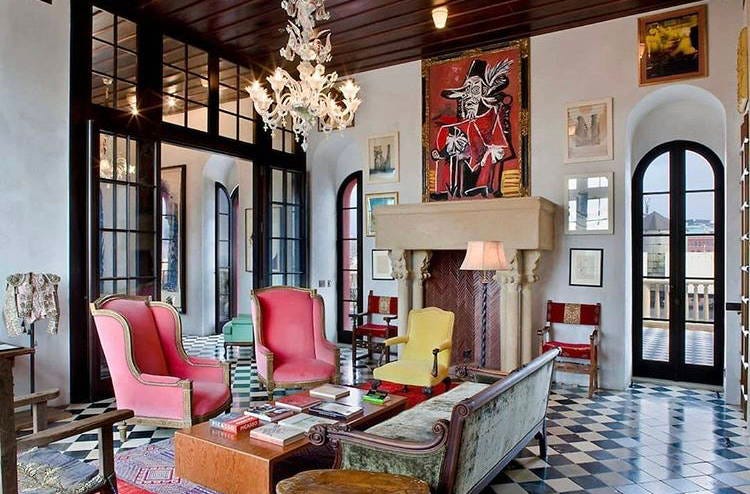Photo by Alfons Morales on Unsplash
Every property owner has certain items he or she feels particularly attached to. It can be a chair, a couch or an art piece. When the time for a makeover comes, interior designers are confronted with the challenge of integrating these pieces into their new project. Many interior designers get nervous about placing old art into a contemporary setting, but it doesn’t have to be that way.
Old paintings can be used to add depth and character to a room. Consequently, simple shapes and muted hues of contemporary interior design can help reinterpret the art piece and make it look fresh and exciting again. In this article, we’ll give you a few ideas about how to incorporate old paintings into your new design without disrupting the visual balance of the place.

// Select Your Color Palette
Vintage art can be a great starting point for picking the color palette for your design. Looking at all those shades of paint in a home improvement store can seem intimidating. But if you use artwork as inspiration, you can easily structure your color scheme.
Pick two or three shades from the artwork and incorporate them into your design. Select one hue for the dominant color, while others can serve as accents. Then look for furniture pieces and wall paint that will match these shades. If you are not sure which color to use on the wall, you can use apps like ColorSnap to virtually paint your walls in different shades.
// Discover the Story Behind the Piece
Every artwork has a story. If the piece has a special significance for homeowners, make sure to learn more about it and discover why they love it. Maybe the piece reminds them of a person that they used to know or a trip they enjoyed. Understanding why your clients feel personally attached to the piece will help you find the perfect place for it.
If they own a portrait of a loved one, the dining area can be the perfect place for the display, as it will give clients a notion of drinking their coffee with the people they love. A portrait of a person your client looks up to will serve as an excellent motivational piece in the study. An artwork purchased on vacation can be placed in the bedroom, where it will remind your clients of the joy of travel before they go to sleep.

// Use it as a Focal Point
Every interior design project needs a focal point — one item or element that draws the viewer’s eyes and brings together the entire space. An old art piece can be a perfect focal point for every room. This particularly goes for bigger art pieces, as they tend to naturally stand out and demand the viewers’ attention. Realistic depictions of biblical and historical motifs can add character to the space, while tapestry can make the entire room look and feel cozy.
// Use Art to Accentuate Architectural Elements
Placing an old piece above a vintage fireplace seems like a logical idea, but many interior designers avoid this set-up as they fear that it will make the place look too traditional. But if you tastefully mix old paintings and architectural elements with modern furniture and contemporary paint colors, you’ll ensure that the space looks stylish. Mix old art, ravishing crystal chandeliers and crown molding with muted, neutral tones to make the room look fashionable, while simultaneously honoring the original architectural design of the place.

// Incorporate the Art into a Bigger Collection
Use artworks of similar subject matter, color, and style to create a vivid collection spanning through the room. To make the display more interesting, use the asymmetrical arrangement to form an abstract pattern on the wall. Surround the artwork with an eclectic collection of furniture that will add a modern note to the project.
// Leaning Artwork
Leaning an artwork on the wall or a shelf or even directly on another artwork can make the room feel more relaxed. Even a rigid, formal portrait can appear casual and youthful when leaned against the wall. Large artworks can be placed on the floor and leaned on the wall and smaller artworks can be elevated to bookshelves and coffee tables. Or you can lean a smaller artwork on top of a bigger artwork to add depth and spark interest. Just like a book standing on the shelf, the leaned artwork will inspire people to pick it up and carefully inspect it.
// Juxtapose Old and Contemporary Pieces
Many contemporary artists have created pieces inspired by old masters paintings and drawings. So why not emphasize the similarities between contemporary painters and old masters by juxtaposing artworks from different art periods. By placing contemporary and old pieces side by side, you will powerfully portray the evolution of art through time.
When placed in a contemporary setting, old art pieces can bring something new to the space. They can add a touch of elegance and museum-quality to the room. Or a sense of monumentality and nostalgia for times past. So don’t be afraid to include old artworks in your contemporary interior design project. Properly displayed, they can spark imagination and make any room come to life.









